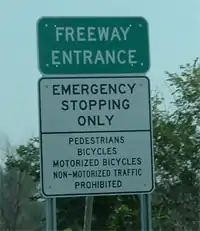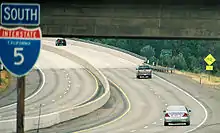Non-motorized access on freeways
Non-motorized access on freeways may allow or restrict pedestrians, bicyclists and other non-motorized traffic to use a freeway. Such roads are public ways intended primarily for high-speed travel over long distances, and they have resulted in highways in the United States with engineering features such as long sight-distances, wide marked lanes and the absence of cross traffic. These provide faster and safer travel.

Freeways are usually limited to motor vehicles of a minimum power or weight; signs may prohibit bicyclists, pedestrians and equestrians and impose a minimum speed. It is possible for non-motorized traffic to use facilities within the same right-of-way, such as sidewalks constructed along freeway-standard bridges and multi-use paths next to freeways such as the Suncoast Trail along the Suncoast Parkway in Florida.
In some US jurisdictions, especially where freeways replace existing roads, non-motorized access on freeways is the rule. Different states of the United States have different laws. Cycling on freeways in Arizona may be prohibited only where there is an alternative route judged equal or better for cycling.[1] Wyoming, the least populated state, allows cycling on all freeways. Oregon allows bicycles except on specific urban freeways in Portland and Medford.[2]
In countries such as the United Kingdom and Germany, the difference between a normal road and a freeway-class road (motorway or autobahn) is the restriction of low-speed traffic. Many roads are built to freeway standards but are not legally freeway-class roads for this reason. Indeed, some freeway-class roads are downgraded for short stretches where no alternative exists, to allow low-speed traffic; examples in the UK include the Dartford Crossing (the furthest downstream public crossing of the Thames), and the former Cumberland Gap, as well as sections of the A1 not yet designated A1(M), various lengths of the A5, and the entirety of other important and near-motorway-standard links such as the A14, A34, A38, A42, A50, and A55 road, long stretches of which carry 70 miles per hour (110 km/h) speed limits. The reasons for such designation vary—physical lack of space (A55), restricted budget (e.g. A42; a full-standard motorway would have been more expensive than an A-road; a motorway with additional service roads further still), or because of legislative or political wrangling (easier to have A-road construction or upgrade authorised and accepted than a more emotionally charged "motorway scheme", and does not require issuing of Special Road orders). Continental European non-motorway dual carriageways can have limits as high as 110–120 kilometres per hour (68–75 mph). U.S. Route 23 in Ohio has a speed limit as high as 65 miles per hour (105 km/h) but isn't legally a freeway-class road since it has no disclaimers saying that low-speed vehicles are prohibited; it also has at-grade intersections like expressway-class roadways.
Research shows 85 percent of motor vehicle-bicycle crashes follow turning or crossing at intersections.[3] Freeway travel eliminates almost all those conflicts save at entrance and exit ramps—which, at least on those freeways where cycling has not been banned, have sufficient room and sight for cyclists and motorists. An analysis of crashes in Arizona showed no safety problems with cycling on freeways. Fewer than one motor vehicle-bicycle crash a year was recorded on nearly 2000 shoulder-miles open to cyclists in Arizona.[4]
Bike freeways
Bike freeways are long-distance cycle tracks with few intersections intended for long-distance travel with access restricted for motorized vehicles and usually pedestrians.
U.S. states permitting bicycle use on interstate highways

Most U.S. States with low population densities commonly permit bicycle use on interstate freeways outside urban areas. Additionally, some states permit bicycle use on at least some interstate routes specially designated to accommodate bikes.
| State | Regulation[5] |
| Alabama | Prohibited (possible exceptions) |
| Alaska | Allowed if no suitable alternative |
| Arizona | Allowed if no suitable alternative |
| Arkansas | Prohibited (possible exceptions) |
| California | Allowed if no suitable alternative |
| Colorado | Allowed if no suitable alternative |
| Connecticut | Prohibited (possible exceptions) |
| Delaware | Prohibited (possible exceptions) |
| District of Columbia | Discouraged, but not prohibited |
| Florida | Prohibited (possible exceptions) |
| Georgia | Prohibited (possible exceptions) |
| Hawaii | Prohibited (possible exceptions) |
| Idaho | Allowed on all interstates |
| Illinois | Prohibited (possible exceptions) |
| Indiana | Prohibited (possible exceptions) |
| Iowa | Prohibited (possible exceptions) |
| Kansas | Prohibited (possible exceptions) |
| Kentucky | Prohibited (possible exceptions) |
| Louisiana | Prohibited (possible exceptions) |
| Maine | Prohibited (possible exceptions) |
| Maryland | Prohibited (possible exceptions) |
| Massachusetts | Prohibited (possible exceptions) |
| Michigan | Prohibited (possible exceptions) |
| Minnesota | Prohibited (possible exceptions) |
| Mississippi | Prohibited (possible exceptions) |
| Missouri | Discouraged, but not prohibited |
| Montana | Allowed on all interstates |
| Nebraska | Prohibited (possible exceptions) |
| Nevada | Allowed if no suitable alternative |
| New Hampshire | Prohibited (possible exceptions) |
| New Jersey | Allowed with permit |
| New Mexico | Allowed if no suitable alternative |
| New York | Prohibited (possible exceptions) |
| North Carolina | Prohibited (possible exceptions) |
| North Dakota | Allowed on all interstates |
| Ohio | Prohibited (possible exceptions) |
| Oklahoma | Discouraged, but not prohibited |
| Oregon | Allowed unless prohibited[6] |
| Pennsylvania | Allowed if no suitable alternative |
| Rhode Island | Prohibited (possible exceptions) |
| South Carolina | Prohibited (possible exceptions) |
| South Dakota | Allowed on all interstates |
| Tennessee | Prohibited (possible exceptions) |
| Texas | Discouraged, but not prohibited |
| Utah | Allowed if no suitable alternative |
| Vermont | Prohibited (possible exceptions) |
| Virginia | Prohibited (possible exceptions) |
| Washington | Allowed unless prohibited |
| West Virginia | Prohibited (possible exceptions) |
| Wisconsin | Prohibited (possible exceptions) |
| Wyoming | Allowed on all interstates |
References
- Staff (November 2011). "1030: Controlled-Access Highways as Bikeways" (PDF). ADOT Traffic Engineering Policies, Guidelines, and Procedures. Arizona Department of Transportation. Retrieved December 28, 2012.
- Staff. "OAR Banning Non-Motorized Travel On Some Interstate Freeways in Oregon" (PDF). Oregon Department of Transportation. Archived from the original (PDF) on May 31, 2010. Retrieved October 12, 2009.
- Pion, Martin (13 May 2006). "Bicycling facts and figures". Ferguson Pilot B.I.K.E. Project. Archived from the original on July 20, 2008.
- Moeur, Richard C. (October 2002). "Bicycle–Motor Vehicle Collisions on Controlled Access Highways in Arizona: Analysis from January 1, 1991 to June 30, 2002" (PDF). Arizona Department of Transportation. Archived from the original (PDF) on May 25, 2011. Retrieved December 28, 2012.
- "State by State Information". Pedestrian and Bicycle Information Center. Archived from the original on 2019-03-22. Retrieved 2019-03-21.
- Staff. "OAR Banning Non-Motorized Travel On Some Interstate Freeways in Oregon" (PDF). Oregon Department of Transportation. Archived from the original (PDF) on May 31, 2010. Retrieved October 12, 2009.